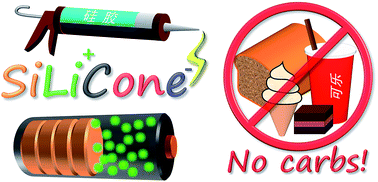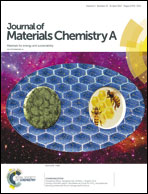Novel hybrid Si nanocrystals embedded in a conductive SiOx@C matrix from one single precursor as a high performance anode material for lithium-ion batteries†
Abstract
Silicon (Si) is a promising anode material for lithium-ion batteries (LIBs) owing to its very high lithium storage capacity; however, fragmentation of Si caused by drastic volume change during lithium insertion and extraction leads to serious capacity decay during cycling. In this work, we report a novel method to synthesize an in situ nanocomposite containing Si nanoparticles evenly embedded in an electrically conductive SiOx@C network (Si/SiOx@C) from one single polysiloxane precursor. In our process, Si nanocrystals were reduced from the polysiloxane precursor using a low temperature molten salt reduction method, and carbon segregated out in the SiOx@C phase which evolved during the subsequent pyrolysis. As an anode material for LIBs, the Si/SiOx@C nanocomposite showed a specific capacity up to 1292 mA h g−1 at a current density of 0.4 A g−1 and 81.84% capacity retention after 200 cycles. The high capacity and stable performance of Si/SiOx@C as an anode material can be attributed to the continuous SiOx@C matrix which provides reliable mechanical support, electronic and ionic conductivity, and a stable solid–electrolyte interphase (SEI). This work demonstrated the viability of deriving a homogenous nanocomposite from a single polymeric precursor, which creates a promising anode material for next-generation LIBs.



 Please wait while we load your content...
Please wait while we load your content...